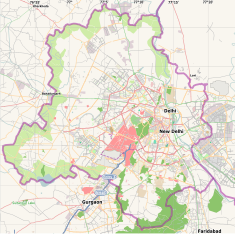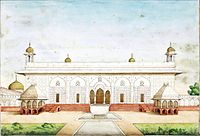Red Fort
| Red Fort | |
|---|---|
 A view of the Red Fort's Lahori Gate | |
| Location | Old Delhi, Delhi, India |
| Coordinates | 28°39′21″N 77°14′27″E / 28.65583°N 77.24083°E |
| Height | 18–33 m (59–108 ft) |
| Built | 12 May 1639 – 6 April 1648 |
| Architect | Ustad Ahmad Lahori |
| Architectural style(s) | Indo-Islamic architecture |
| Owner |
|
| Official name | Red Fort Complex |
| Type | Cultural |
| Criteria | ii, iii, vi |
| Designated | 2007 (31st session) |
| Reference no. | 231rev |
| Region | Indo-Pacific |
The Red Fort or Lal Qila (Hindustani: [laːl qiːlaː]) is a historic fort in the Old Delhi neighbourhood of Delhi, India, that historically served as the main residence of the Mughal emperors. Emperor Shah Jahan commissioned construction of the Red Fort on 12 May 1638, when he decided to shift his capital from Agra to Delhi. Originally red and white, its design is credited to architect Ustad Ahmad Lahori, who also constructed the Taj Mahal. The fort represents the peak in Mughal architecture under Shah Jahan and combines Persianate palace architecture with Indian traditions.
The fort was plundered of its artwork and jewels during Nader Shah's invasion of the Mughal Empire in 1739. Most of the fort's marble structures were subsequently demolished by the British following the Indian Rebellion of 1857. The fort's defensive walls were largely undamaged, and the fortress was subsequently used as a garrison.
On 15 August 1947, the first prime minister of India, Jawaharlal Nehru, raised the Indian flag above the Lahori Gate. Every year on India's Independence Day (15 August), the prime minister hoists the Indian tricolour flag at the fort's main gate and delivers a nationally broadcast speech from its ramparts through the Public Address System of Indian Army Signals.
The Red Fort was designated a UNESCO World Heritage Site in 2007 as part of the Red Fort Complex.[1][2]
Etymology
The name Red Fort is a translation of the Hindustani Lāl Qila (Hindi: लाल क़िला, Urdu: لال قلعہ),[3][4] deriving from its red sandstone walls. Lal was derived from Hindustani language meaning "Red" and Qalàh derived from Arabic word meaning "Fortress". As the residence of the imperial family, the fort was originally known as the "Blessed Fort" (Qila-i-Mubārak).[5][6] Agra Fort is also known as Lāl Qila.
History
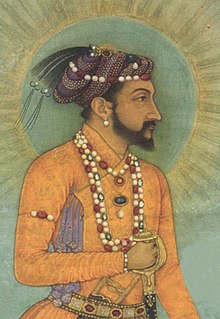
Emperor Shah Jahan commissioned construction of the Red Fort on 12 May 1638, when he decided to shift his capital from Agra to Delhi. Originally red and white, Shah Jahan's favourite colours,[7] its design is credited to architect Ustad Ahmad Lahori, who also constructed the Taj Mahal.[8][9] The fort lies along the Yamuna River, which fed the moats surrounding most of the walls.[10] Construction began in the sacred Islamic month of Muharram, on 13 May 1638.[11]: 01 Supervised by Shah Jahan, it was completed on 6 April 1648.[12][13][14] Unlike other Mughal forts, the Red Fort's boundary walls are asymmetrical to contain the older Salimgarh Fort.[11]: 04 The fortress-palace was a focal point of the city of Shahjahanabad, which is present-day Old Delhi. Shah Jahan's successor, Aurangzeb, added the Moti Masjid (Pearl Mosque) to the emperor's private quarters, constructing barbicans in front of the two main gates to make the entrance to the palace more circuitous.[11]: 08

The administrative and fiscal structure of the Mughal dynasty declined after Aurangzeb, and the 18th century saw a degeneration of the palace. In 1712 Jahandar Shah became the Mughal Emperor. Within a year of beginning his rule, Shah was murdered and replaced by Farrukhsiyar. In 1739, Persian emperor Nadir Shah easily defeated the strong Mughal army of around 200,000 soldiers,[15] plundering the Red Fort, including the Peacock Throne. Nadir Shah returned to Persia after three months, leaving a destroyed city and a weakened Mughal empire to Muhammad Shah.[11]: 09 The internal weakness of the Mughal Empire made the Mughals only titular rulers of Delhi, and a 1752 treaty made the Marathas protectors of the throne at Delhi.[16][17] The 1758 Maratha victory at Sirhind aided by the Sikhs and successive defeat at Panipat[18] placed them in further conflict with Ahmad Shah Durrani.[19][20]
In 1760, the Marathas removed and melted the silver ceiling of the Diwan-i-Khas to raise funds for the defence of Delhi from the armies of Ahmed Shah Durrani.[21][22] In 1761, after the Marathas lost the third battle of Panipat, Delhi was raided by Ahmed Shah Durrani. Ten years later, the Marathas, acting on the behest and as mercenary of the exiled Emperor Shah Alam, recaptured Delhi from the Rohilla Afghans. Mahadji Scindia, the commander of Maratha army bowed to Mughal Emperor Shah Alam to demonstrate his submission to him.[23] Thus, Shah Alam was restored to the throne.
In 1764, the Jat ruler of Bharatpur, Maharaja Jawahar Singh (the son of Maharaja Suraj Mal) attacked Delhi and captured the Red Fort of Delhi on 5 February 1765.[24] Two days later, after taking tribute from the Mughals, removed their armies from the fort and the Jats took away the throne of the Mughals, called the pride of the Mughals, and the doors of the Red Fort as a memorial, and this throne is today enhancing the beauty of the palaces of Deeg. The doors are located in the Lohagarh Fort of Bharatpur.[25]
In 1783 Sikh Misls led by Jassa Singh Ahluwalia, Jassa Singh Ramgarhia, and Baghel Singh conquered Delhi and the Red Fort. All allied with a 40,000 force, looted the area from Awadh to Jodhpur. After negotiations, the Sikhs forces agreed to leave Delhi and reinstate the Mughal emperor Shah Alam II. The condition of their retreat included the construction of seven Sikh Gurdwaras in Delhi, including the Gurudwara Sis Ganj in Chandni Chowk.[26]
In 1788, a Maratha garrison occupied the Red Fort and Delhi alongside providing protection to the Mughal Emperor. Mahadji Scindia signed a treaty with the Sikhs where they were warned not to enter Delhi or ask for the Rakhi tribute. The fort came under the control of the East India Company following the Second Anglo-Maratha War in 1803.[27]
During the Second Anglo-Maratha War, forces of the East India Company defeated Maratha forces of Daulat Rao Scindia in the Battle of Delhi; this ended Maratha control over the city and their control of the Red Fort.[28] After the battle, the British East India Company took over the administration of Mughal territories and installed a Resident at the Red Fort.[11]: 11 The last Mughal emperor to occupy the fort, Bahadur Shah II, became a symbol of the 1857 rebellion against the British East India Company in which the residents of Shahjahanabad participated.[11]: 15
Despite its position as the seat of Mughal power and its defensive capabilities, the Red Fort was not a site of an engagement during the 1857 uprising against the British. After the rebellion was defeated, Bahadur Shah II left the fort on 17 September and was apprehended by British forces. Bahadur Shah Zafar II returned to Red Fort as a British prisoner, was tried in 1858 and exiled to Rangoon on 7 October of that year.[29] After the end of the rebellion, the British sacked the Red Fort before ordering its systemic demolition. 80% of the fort’s buildings were demolished as a result of this effort, including the stone screen that connected the pavilions along the fort’s river-facing façade, which was demolished.[30] All furniture was removed or destroyed; the harem apartments, servants' quarters and gardens were demolished, and a line of stone barracks built in their place.[31] Only the marble buildings on the east side at the imperial enclosure escaped complete destruction, although they were damaged by the demolition efforts. While the defensive walls and towers were relatively unharmed, more than two-thirds of the inner structures were demolished.[citation needed]
Lord Curzon, Viceroy of India from 1899 to 1905, ordered repairs to the fort including reconstruction of the walls and the restoration of the gardens complete with a watering system.[32]

Most of the jewels and artwork located in the Red Fort were looted during Nadir Shah's invasion of 1747 and again after the Indian Rebellion of 1857 against the British. They were eventually sold to private collectors or the British Museum, the British Library and the Victoria and Albert Museum. For example, the jade wine cup of Shah Jahan and the crown of Bahadur Shah II are all currently located in London. Various requests for restitution have so far been rejected by the British government.[33]

1911 saw the visit of King George V and Queen Mary for the Delhi Durbar. In preparation for their visit, some buildings were restored. The Red Fort Archaeological Museum was moved from the drum house to the Mumtaz Mahal.
The INA trials, also known as the Red Fort Trials, refer to the courts-martial of a number of officers of the Indian National Army. The first was held between November and December 1945 at the Red Fort.
On 15 August 1947, the first prime minister of India, Jawaharlal Nehru raised the Indian national flag above the Lahore Gate.[34]
After Indian Independence, the site experienced few changes, and the Red Fort continued to be used as a military cantonment. A significant part of the fort remained under Indian Army control until 22 December 2003, when it was given to the Archaeological Survey of India for restoration.[35][36] In 2009 the Comprehensive Conservation and Management Plan (CCMP), prepared by the Archaeological Survey of India under Supreme Court directions to revitalise the fort, was announced.[37][38][39]
Archaeological finds
Archaeological excavations at the Red Fort have unearthed several Ochre Coloured Pottery culture artifacts dating from 2600 BCE to 1200 BCE.[40]
Modern era


The Red Fort, the largest monument in Delhi,[41] is one of its most popular tourist destinations[42] and attracts thousands of visitors every year.[43] It is a monument of national significance; every year on India's Independence Day (15 August), the prime minister of India hoists the country's flag at the Red Fort and delivers a nationally broadcast speech from its ramparts.[44] The fort also appears on the back of the ₹500 note of the Mahatma Gandhi New Series of the Indian rupee.[45]
The major architectural features are in mixed condition; the extensive water features are dry. Some buildings are in fairly good condition, with their decorative elements undisturbed; in others, the marble inlaid flowers have been removed by looters. The tea house, although not in its historical state, is a working restaurant. The mosque and hammam or public baths are closed to the public, although visitors can peer through their glass windows or marble latticework. Walkways are crumbling, and public toilets are available at the entrance and inside the park. The Lahori Gate entrance leads to a mall with jewellery and craft stores. There is also a museum of "blood paintings", depicting young 20th-century Indian martyrs and their stories, an archaeological museum and an Indian war-memorial museum.[citation needed]
2000 terrorist attack
The Red Fort was the site of a terrorist attack on 22 December 2000, carried out by six Lashkar-e-Taiba members. Two soldiers and a civilian were killed in what the news media described as an attempt to derail India-Pakistan peace talks.[46][47]
Security
To prevent terrorist attacks, security is especially strict around the Red Fort on the eve of Indian Independence Day. Delhi Police and paramilitary personnel keep a watch on neighbourhoods around the fort, and National Security Guard sharpshooters are deployed on high-rises near the fort.[48][49] The airspace around the fort is a designated no-fly zone during the celebration to prevent air attacks,[50] and safe houses exist in nearby areas to which the prime minister and other Indian leaders may retreat in the event of an attack.[48]
Adoption controversy
In April 2018, Dalmia Bharat Group adopted the Red Fort for maintenance, development, and operations, per a contract worth ₹25 crores for a period of five years, under the government's "Adopt A Heritage" scheme.[51] The memorandum of understanding was signed with the ministries of Tourism and Culture, and the Archaeological Survey of India (A.S.I.).[52] The adoption of the fort by a private group left people divided and drew criticism from the public, opposition political parties, and historians. It also led to the #IndiaOnSale hashtag on Twitter.[53] In May 2018, the Indian History Congress called for the deal to be suspended until there is an "impartial review" of the deal "by the Central Advisory Board of Archaeology or any other recognised body of experts".[54]
2021 Indian farmers' Republic Day protest
On 26 January 2021, during the 2021 Indian farmers' Republic Day protest, a section of the farmers reached and entered the fort and hoisted religious flags from the ramparts and climbed up the domes of the fort.[55] One of the farmers was seen climbing a flagpole in front of the fort and hoisting the religious flag Nishan Sahib on the flagpole.[56] The clash between police and farmers also caused damage to facilities inside the fort.[57] The fort was vacated following police announcements.
Architecture
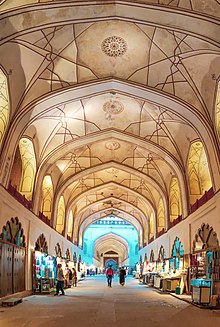
The World Heritage Convention characterises the Red Fort as representing "the zenith of Mughal creativity". The fort synthesises Islamic palace structure with local traditions, resulting in a confluence of "Persian, Timurid, and Hindu architecture". The fort served as an inspiration for later buildings and gardens across the Indian subcontinent.[1]
The Red Fort has an area of 254.67 acres (103.06 ha) enclosed by 2.41 kilometres (1.50 mi) of defensive walls,[58] punctuated by turrets and bastions that vary in height from 18 metres (59 ft) on the river side to 33 metres (108 ft) on the city side. The fort is octagonal, with the north–south axis longer than the east–west axis. The marble, floral decorations and the fort's double domes exemplify later Mughal architecture.[59]
It showcases a high level of ornamentation, and the Kohinoor diamond was reportedly part of the furnishings. The fort's artwork synthesises Persian, European and Indian art, resulting in a unique Shahjahani style rich in form, expression and colour. Red Fort is one of the building complexes of India encapsulating a long period of history and its arts. Even before its 1913 commemoration as a monument of national importance, efforts were made to preserve it for posterity.
The Lahori and Delhi Gates were used by the public, and the Khizrabad Gate was for the emperor.[11]: 04 The Lahori Gate is the main entrance, leading to a domed shopping area known as the Chatta Chowk (covered bazaar).
Major structures
The most important surviving structures are the walls and ramparts, the main gates, the audience halls and the imperial apartments on the eastern riverbank.[60]
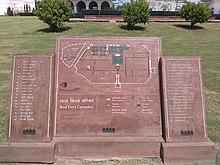
Lahori Gate

The Lahori Gate is the main gate to the Red Fort, named for its orientation towards the city of Lahore. During Aurangzeb's reign, the beauty of the gate was altered by the addition of a barbican, which Shah Jahan described as "a veil drawn across the face of a beautiful woman".[61][62][63] Every Indian Independence Day since 1947, the national flag is unfurled and the prime minister makes a speech from its ramparts.
Delhi Gate
The Delhi Gate is the southern public entrance and is similar in layout and appearance to the Lahori Gate. Two life-size stone elephants on either side of the gate face each other.[64]
Chhatta Chowk
Adjacent to the Lahori Gate is the Chhatta Chowk (or Meena Bazaar), where silk, jewellery and other items for the imperial household were sold during the Mughal period. This market was earlier known as Bazaar-i-Musaqqaf or Chatta-bazaar (both meaning "roofed market"). Lahori Gate, the entrance portal of the Red Fort, leads into an open outer court, where it crosses the large north–south street which originally divided the fort's military functions (to the west) from the palaces (to the east). The southern end of the street is the Delhi Gate.[65]
Naubat Khana

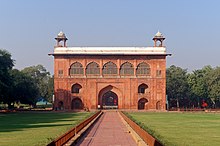
In the east wall of the court stands the now-isolated Naubat Khana (Persian: "Waiting Hall"), also known as Nakkar Khana (drum house). Music was played daily, at scheduled times and everyone, except royalty, were required to dismount. Later Mughal kings Jahandar Shah (1712–13) and Farrukhsiyar (1713–19) are said to have been murdered here. The Indian War Memorial Museum is located on the second floor.[66] The vaulted arcade of the Chhatta Chowk ends in the centre of the outer court, which measured 540 by 360 feet (160 m × 110 m).[67] The side arcades and central tank were demolished after the 1857 rebellion.
Diwan-i-Aam

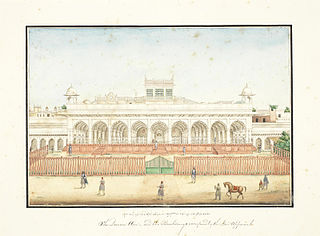
The inner main court to which the Nakkar Khana led was 540 feet (160 m) wide and 420 feet (130 m) deep, surrounded by guarded galleries.[67] On the far side is the Diwan-i-Aam, the Public Audience Hall. This was a place for the official affairs of commoners who sought after legal matters such as tax issues, hereditary complications, and awqaf.
The hall's columns and engrailed arches exhibit fine craftsmanship, and the hall was originally decorated with white chunam stucco.[67] In the back in the raised recess the emperor gave his audience in the marble balcony (jharokha).
The Diwan-i-Aam was also used for state functions.[59] The courtyard (mardana) behind it leads to the imperial apartments.
Mumtaz Mahal

The two southernmost pavilions of the palace are zenanas (women's quarters), consisting of the Mumtaz Mahal built for Arjumand Banu Begum (Mumtaz Mahal) wife of the Mughal emperor Shah Jahan[68] and the larger Rang Mahal a resort for royal women.[69] The Mumtaz Mahal houses the Red Fort Archaeological Museum.
Rang Mahal
The Rang Mahal housed the emperor's wives and mistresses. Its name means "Palace of Colours", since it was brightly painted and decorated with a mosaic of mirrors. The central marble pool is fed by the Nahr-i-Bihisht ("River of Paradise").[70][69]
Khas Mahal
The Khas Mahal was the emperor's apartment. It was cooled by the Nahr-i-Bihisht.[70] Connected to it is the Muthamman Burj, an octagonal tower where he appeared before the people waiting on the riverbank. This was done by most kings at the time.[71]
Diwan-i-Khas

The Diwan-i-Khas (Hall of Private Audience) was a building for the official affairs and requests of the novelty and royal family. A gate on the north side of the Diwan-i-Aam leads to the innermost court of the palace (Jalau Khana) and the Diwan-i-Khas.[72] It is constructed of white marble, inlaid with precious stones. The once-silver ceiling has been restored in wood. François Bernier described seeing the jewelled Peacock Throne here during the 17th century. At either end of the hall, over the two outer arches, is an inscription by Persian poet Amir Khusrow:
If heaven can be on the face of the earth,
It is this, it is this, it is this.
— "World Heritage Site – Red Fort, Delhi; Diwan-i-Khas". Archaeological Survey of India. Retrieved 15 August 2012.
Hammam

The hammam (Arabic: حمّام) were the imperial baths, consisting of three domed rooms with white marble patterned floors.[73] It consists of three apartments separated by corridors and crowned with domes. The apartments are illuminated by a colored glass skylight. The two rooms to either side of the present entrance are believed to have been used by the royal children for bathing. The eastern apartment, containing three fountain basins, was used primarily as a dressing room. In the center of each room stood a fountain, and one of the rooms contained a marble reservoir built into the wall. As legend goes, perfumed rose-water once ran from the taps. The western apartment was used for hot or vapor baths, and the heating arrangement was being fixed in its western wall.[74]
Baoli

The baoli or step-well is one of the few monuments that were not demolished by the British after the Indian Rebellion of 1857. The chambers within the baoli were converted into a prison. During the Indian National Army Trials (Red Fort Trials) in 1945–46, it housed Indian National Army officers Shah Nawaz Khan (general), Colonel Prem Kumar Sahgal, and Colonel Gurbaksh Singh Dhillon. The Red Fort Baoli is uniquely designed with two sets of staircases leading down to the well.[75]

Moti Masjid
West of the hammam is the Moti Masjid, the Pearl Mosque. A later addition, it was built in 1659 as a private mosque for Emperor Aurangzeb. It is a small, three-domed mosque carved in white marble, with a three-arched screen leading down to the courtyard.[76]
Hira Mahal

The Hira Mahal ("Diamond Palace") is a pavilion on the southern edge of the fort, built under Bahadur Shah II and at the end of the Hayat Baksh garden.[77] The Moti Mahal on the northern edge, a twin building, was demolished during (or after) the 1857 rebellion. The Shahi Burj was the emperor's main study; its name means "Emperor's Tower",[78] and it originally had a chhatri on top. Heavily damaged, the tower is undergoing reconstruction. In front of it is a marble pavilion added by Emperor Aurangzeb.[79]
Hayat Bakhsh Bagh
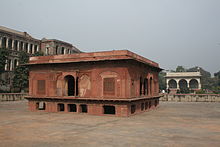
The Hayat Bakhsh Bagh (Persian: حیات بخش باغ, lit. 'Life-Bestowing Garden') is located in the northeast part of the complex. It features a reservoir, which is now dry, and channels through which the Nahr-i-Bihisht flows. At each end is a white marble pavilion, called the Sawan and Bhadon Pavilions, Hindu months, Sawan and Bhadon. In the centre of the reservoir is the red-sandstone Zafar Mahal, added in around 1842 by Bahadur Shah Zafar, and named after him.[80]
Smaller gardens (such as the Mehtab Bagh or Moonlight Garden) existed west of it, but were demolished when the British barracks were built.[11] There are plans to restore the gardens.[81] Beyond these, the road to the north leads to an arched bridge and the Salimgarh Fort.
Princes' quarter
To the north of the Hayat Bakhsh Bagh and the Shahi Burj is the quarter of the imperial princes. This was used by member of the Mughal royal family and was largely demolished by the British forces after the 1857 rebellion. One of the palaces was converted into a tea house for the soldiers.
See also
References
- ^ a b "Red Fort Complex". World Heritage List. UNESCO World Heritage Centre. Archived from the original on 3 August 2009. Retrieved 15 November 2009.
- ^ "Red Fort was designated a UNESCO World Heritage Site in 2007". Lonely Planet. Archived from the original on 29 April 2012. Retrieved 4 August 2012.
- ^ "qila | Meaning of qila in English by Shabdkosh English Hindi Dictionary". Shabdkosh Dictionary. Archived from the original on 11 November 2013. Retrieved 2 June 2018.
- ^ "qila | Definition of qila in English by Oxford Dictionaries". Oxford Dictionaries | English. Archived from the original on 3 April 2018. Retrieved 3 April 2018.
- ^ William M. Spellman (1 April 2004). Monarchies 1000–2000. Reaktion Books. ISBN 978-1-86189-087-0. Archived from the original on 14 December 2011. Retrieved 5 August 2012.
- ^ Mehrdad Kia; Elizabeth H. Oakes (1 November 2002). Social Science Resources in the Electronic Age. Greenwood Publishing Group. ISBN 978-1-57356-474-8. Archived from the original on 11 January 2014. Retrieved 5 August 2012.
- ^ Nelson, Dean (20 May 2011). "Delhi's Red Fort was originally white". The Daily Telegraph (UK).
- ^ "Ustad Ahmad – oi". oxfordindex.oup.com. Retrieved 8 December 2019.[dead link]
- ^ "Building the Taj – who designed the Taj Mahal". PBS. Archived from the original on 18 February 2014. Retrieved 13 August 2013.
- ^ "Red Fort lies along the River Yamuna". Archived from the original on 14 August 2012. Retrieved 4 August 2012.
- ^ a b c d e f g h "Comprehensive Conservation Management Plan for Red Fort, Delhi" (PDF). Archaeological Survey of India. March 2009. Archived (PDF) from the original on 8 May 2012. Retrieved 14 August 2012.
- ^ Elliot, H. M. (Henry Miers) (26 September 1875). "Shah Jahan". [Lahore : Sh. Mubarak Ali. Retrieved 26 September 2020 – via Internet Archive.
- ^ "List of Muhammadan and Hindu monuments vol.1". 1916. Retrieved 4 March 2020.
- ^ Pinto, Xavier; Myall, E. G. (2009). Glimpses of History. Frank Brothers. p. 129. ISBN 978-81-8409-617-0. Archived from the original on 11 January 2014. Retrieved 25 September 2016.
- ^ "Battle of Karnal | Summary". Encyclopedia Britannica. Retrieved 24 May 2021.
- ^ Mehta, J. L. (2005). Advanced Study in the History of Modern India: Volume One: 1707–1813. Sterling Publishers Pvt. Ltd. p. 134. ISBN 978-1-932705-54-6. Archived from the original on 12 January 2014. Retrieved 25 September 2016.
- ^ Jayapalan, N. (2001). History of India. Atlantic Publishers & Distri. p. 249. ISBN 978-81-7156-928-1. Archived from the original on 12 January 2014. Retrieved 25 September 2016.
- ^ Advanced Study in the History of Modern India: 1707–1813 – Jaswant Lal Mehta – Google Books. Google Books. Retrieved 29 July 2013.
- ^ Roy, Kaushik (2004). India's Historic Battles: From Alexander the Great to Kargil. Permanent Black, India. pp. 80–81. ISBN 978-81-78241-09-8.
- ^ Elphinstone, Mountstuart (1841). History of India. John Murray, London. p. 276.
- ^ Kulkarni, Uday S. (2012). Solstice at Panipat, 14 January 1761. Pune: Mula Mutha Publishers. p. 345. ISBN 978-81-921080-0-1.
- ^ Kumar Maheshwari, Kamalesh; Wiggins, Kenneth W. (1989). Maratha Mints and Coinage. Indian Institute of Research in Numismatic Studies. p. 140. Archived from the original on 12 January 2014. Retrieved 25 September 2016.
- ^ Dalrymple, William. The Anarchy.
- ^ Meena, P R. RPSC RAS Prelims: History of Rajasthan Complete Study Notes With MCQ. New Era Publication.
- ^ Gupta, Devesh. Rajasthan District G.K.: English Medium. Atharv Publication. p. 134.
- ^ Murphy, Anne (29 November 2012). The Materiality of the Past: History and Representation in Sikh Tradition. OUP USA. ISBN 978-0-19-991629-0.
- ^ Murphy, Anne (2012). The Materiality of the Past: History and Representation in Sikh Tradition. Oxford University Press. p. 151. ISBN 978-0-19-991629-0. Archived from the original on 27 September 2013. Retrieved 25 September 2016.
- ^ Mayaram, Shail (2003). Against History, Against State: Counterperspectives from the Margins. Columbia University Press. p. 202. ISBN 978-0-231-12731-8. Archived from the original on 30 September 2013. Retrieved 25 August 2012.
- ^ Mody, Krutika. "Bahadur Shah II "Zafar"'s significance with Red Fort". Archived from the original on 2 September 2012. Retrieved 4 August 2012.
- ^ Soofi, Delhi's Belly| Mayank Austen (19 August 2011). "The other red corridor". mint. Retrieved 23 May 2021.
- ^ William Dalrymple (2007). "Introduction". The Last Mughal. Penguin Books. p. 7. ISBN 978-0-14-310243-4.
- ^ Eugenia W Herbert (2013). Flora's Empire: British Gardens in India. Penguin Books Limited. p. 333. ISBN 978-81-8475-871-9.
- ^ Nelson, Sara C. (21 February 2013). "Koh-i-Noor Diamond Will Not Be Returned To India, David Cameron Insists". The Huffington Post. Archived from the original on 19 August 2013. Retrieved 27 July 2013.
- ^ PTI (15 August 2013). "Manmohan first PM outside Nehru-Gandhi clan to hoist flag for 10th time". The Hindu. Archived from the original on 21 December 2013. Retrieved 13 May 2014.
- ^ India. Ministry of Defence (2005). Sainik samachar. Director of Public Relations, Ministry of Defence. Archived from the original on 30 September 2013. Retrieved 5 August 2012.
- ^ Muslim India. Muslim India. 2004. Archived from the original on 30 September 2013. Retrieved 5 August 2012.
- ^ "Red Fort facelift to revive Mughal glory in 10 years : Mail Today Stories, News – India Today". Indiatoday.intoday.in. 1 June 2009. Archived from the original on 13 December 2013. Retrieved 3 January 2014.
- ^ "CHAPTER-10_revised_jan09.pmd" (PDF). Archived from the original (PDF) on 8 May 2012. Retrieved 13 May 2014.
- ^ "CHAPTER-00_revisedfeb09.pmd" (PDF). Archived from the original (PDF) on 8 May 2012. Retrieved 13 May 2014.
- ^ Singh, Upinder (2008). A History of Ancient and Early Medieval India From the Stone Age to the 12th Century. Pearson Education India. p. 218. ISBN 9788131711200.
- ^ Schreitmüller, Karen; Dhamotharan, Mohan (CON); Szerelmy, Beate (CON) (14 February 2012). Baedeker India. Baedeker. p. 253. ISBN 978-3-8297-6622-7. Archived from the original on 27 September 2013. Retrieved 25 August 2012.
- ^ Devashish, Dasgupta (2011). Tourism Marketing. Pearson Education India. p. 79. ISBN 978-81-317-3182-6. Archived from the original on 29 September 2013. Retrieved 25 August 2012.
- ^ Murthy, Raja (23 February 2012). "Mughal 'paradise' gets tortuous makeover". Asia Times Online. South Asia. Archived from the original on 20 November 2012. Retrieved 25 August 2012.
{{cite news}}: CS1 maint: unfit URL (link) - ^ "Singh becomes third PM to hoist flag at Red Fort for 9th time". Business Standard. 15 August 2012. Retrieved 17 August 2012.
- ^ "Issue of ₹ 500 banknotes inset letter 'E' in Mahatma Gandhi (New) series after demonitization". Reserve Bank of India. 8 November 2016. Archived from the original on 9 November 2016. Retrieved 9 November 2016.
- ^ "Red Fort attack will not affect peace moves". 19 August 2012. Archived from the original on 3 October 2012. Retrieved 19 August 2012.
- ^ "Red Fort terrorist attacks". 31 March 2012. Archived from the original on 13 May 2013. Retrieved 4 August 2012.
- ^ a b "Security tightened across Delhi on I-Day eve". Daily News and Analysis. 14 August 2012. Archived from the original on 18 August 2012. Retrieved 17 August 2012.
- ^ "Tight security ensures safe I-Day celebration". The Asian Age. 16 August 2012. Archived from the original on 17 November 2017. Retrieved 17 August 2012.
- ^ "Rain Brings Children Cheer, Gives Securitymen a Tough Time". The Hindu. 16 August 2011. Archived from the original on 30 December 2013. Retrieved 27 July 2012.
- ^ Manish, Sai (29 April 2018). "Dalmia Bharat group to adopt Delhi's iconic Red Fort for five years". Business Standard. Archived from the original on 13 May 2019. Retrieved 7 September 2019.
- ^ Krishna, Navmi (30 April 2018). "Red Fort adoption row: The long list of Monument Mitras". The Hindu. Retrieved 7 September 2019.
- ^ Nettikkara, Samiha (30 April 2018). "Indians upset over Red Fort monument 'adoption'". BBC. Archived from the original on 9 July 2019. Retrieved 7 September 2019.
- ^ Pathak, Vikas (2 May 2018). "Historians seek review of Red Fort contract". The Hindu. Retrieved 7 September 2019.
- ^ "India protest: Farmers breach Delhi's Red Fort in huge tractor rally". BBC News. BBC. 26 January 2021. Retrieved 28 January 2021.
- ^ Dawn.com (26 January 2021). "In pictures: Indian farmers enter Delhi's Red Fort as protests break out across the country". Dawn. Pakistan. Retrieved 29 January 2021.
- ^ "ASI shuts Red Fort till January 31 for visitors after vandalism by tractor rally protesters". 28 January 2021. Retrieved 28 January 2021.
- ^ N. L. Batra (May 2008). Delhi's Red Fort by the Yamuna. Niyogi Books. ISBN 9780856676543. Archived from the original on 9 October 2013. Retrieved 5 August 2012.
- ^ a b Langmead; Garnaut, Christine (2001). Encyclopedia of Architectural and Engineering Feats. ABC-CLIO. p. 178. ISBN 978-1-57607-112-0.
- ^ "World Heritage Site – Red Fort, Delhi". Archaeological Survey of India. Archived from the original on 24 December 2014. Retrieved 15 August 2012.
- ^ Fanshawe.H.C (1998). Delhi, Past and Present. Asian Educational Services. pp. 1–8. ISBN 978-81-206-1318-8. Archived from the original on 15 December 2019. Retrieved 10 June 2009.
{{cite book}}:|work=ignored (help) - ^ Sharma p.143
- ^ Mahtab Jahan (2004). "Dilli's gates and windows". MG The Milli Gazette. Archived from the original on 19 June 2017. Retrieved 17 May 2009.
- ^ "World heritage site". Asi.nic.in. Archived from the original on 1 November 2015. Retrieved 3 August 2015.
- ^ Kuriakose, Anthony (15 January 2011). "Chatta Chowk: A market for all reasons". deccanherald.com. Archived from the original on 22 January 2011. Retrieved 12 April 2020.
- ^ "Lal Qila (Red Fort) – Naubat Khana". indiapicks.com. Archived from the original on 11 March 2018. Retrieved 12 April 2020.
- ^ a b c "A handbook for travellers in India, Burma, and Ceylon". Archived from the original on 24 December 2013. Retrieved 3 January 2014.
- ^ Lach, F.; Kley, Edwin J. Van (1998). Asia in the Making of Europe, Volume III: A Century of Advance. Book 2, South Asia. University of Chicago Press. p. 689. ISBN 9780226466972.
- ^ a b "Rang Mahal Delhi, India". archnet.org. Retrieved 12 April 2020.
- ^ a b "Khas Mahal". lonelyplanet.com. Retrieved 12 April 2020.
- ^ "Muthamman-Burj". Archaeological Survey of India. 2011. Archived from the original on 24 November 2013. Retrieved 12 April 2020.
- ^ "Akbar period architecture". britannica.com. Archived from the original on 4 July 2019. Retrieved 12 April 2020.
- ^ "Hammams Red Fort Delhi". liveindia.com. Archived from the original on 30 September 2019. Retrieved 12 April 2020.
- ^ John Murray (Firm) (1911). A handbook for travellers in India, Burma, and Ceylon . University of California Libraries. London : J. Murray; Calcutta : Thacker, Spink, & Co.
- ^ "Red Fort Baoli". agrasenkibaoli.com. Archived from the original on 10 January 2016. Retrieved 1 August 2015.
- ^ World Heritage Series – Red Fort. Published by Director General, Archaeological Survey of India, New Delhi, 2009. ISBN 978-81-87780-97-7
- ^ "Red Fort". culturalindia.net. Archived from the original on 7 April 2019. Retrieved 12 April 2020.
- ^ "Shahi Burj Monument in Old Delhi (Shahjahanabad)". lonelyplanet.com. Retrieved 12 April 2020.
- ^ DK Eyewitness Top 10 Delhi. Penguin. 17 December 2019. ISBN 9781465497246. Retrieved 12 April 2020.
- ^ "World Heritage Site – Red Fort, Delhi; Hayat-Bakhsh Garden and Pavilions". Archaeological Survey of India. Archived from the original on 7 February 2014. Retrieved 15 August 2012.
- ^ "Restoring the lost glory of Red Fort". Times of India. 23 February 2003. Retrieved 12 April 2020.
External links
 Media related to Red Fort at Wikimedia Commons
Media related to Red Fort at Wikimedia Commons- Delhi Tourism | Red Fort
- Dil Udaan | Red Fort Blog
 Geographic data related to Red Fort at OpenStreetMap
Geographic data related to Red Fort at OpenStreetMap
- Red Fort
- Archaeological monuments in Delhi
- Buildings and structures completed in 1648
- Forts in Delhi
- Indian Army bases
- Indian National Army trials
- 17th-century fortifications
- Monuments of National Importance in Delhi
- Mughal fortifications
- Mughal gardens in India
- Persian gardens in India
- Palaces in Delhi
- Royal residences in India
- World Heritage Sites in India
- 1648 establishments in India

